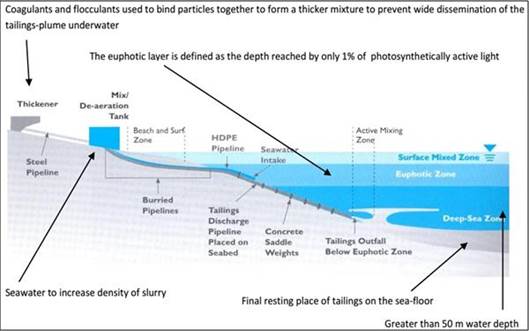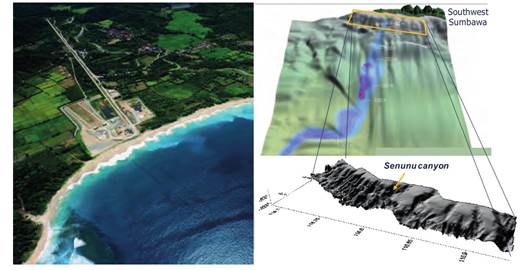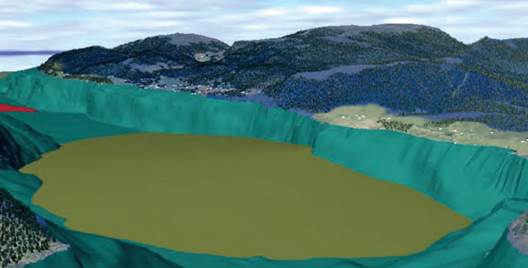INTRODUCTION
Due to the development of the mining works, large volumes of materials are extracted from the earth's crust. Some of them are processed to obtain the mineral products and the rest constitute the mining waste, which are commonly located in large open pit deposits.
In recent times, special attention has been paid to the problem of tailing, primarily with the aim of ensuring the sustainability of mining activities. It has implied the reconciled projection of this mining work with the environmental and social interests.
One of the alternatives for tailing is depositing them underwater (in lakes or seabed). This type of disposal can be very economical and environmentally workable, because with its practice the visual impact caused by the deposits decreases, as well as its limitation to the oxidation reactions that involve the leaching metals and acid generation (IMO 2013; May 2014).
Discharging tailings in the sea is an alternative to the large deposits of these residuals on land. In the specialized literature different technical terms are used to describe the action of storing mining waste at sea, the most commonly terms used are Underwater Tailings Disposal or Deepwater Tailings Disposal (DSTP) (GESAMP 2016).
These systems are at the center of a growing controversy around the world. The main advantages of the method are low investment cost and low operating cost (Poling et al. 2002; IMO 2013; May 2014).
On the other hand, those opposed to this technology argue that it is a way to free industry from the high costs of proper management of tailings by outsourcing this cost to the ocean environment.
According to Koski (2012), the mining practice of deposition waste in coastal areas (shoreline, shallow water and deep water) is an important source of heavy metal contamination.
This author considers that the main negative impact of this activity is the upwelling of toxic elements to the ecosystems, considerably increasing their bioavailability in more than 30 regions of the world (Fig. 1).
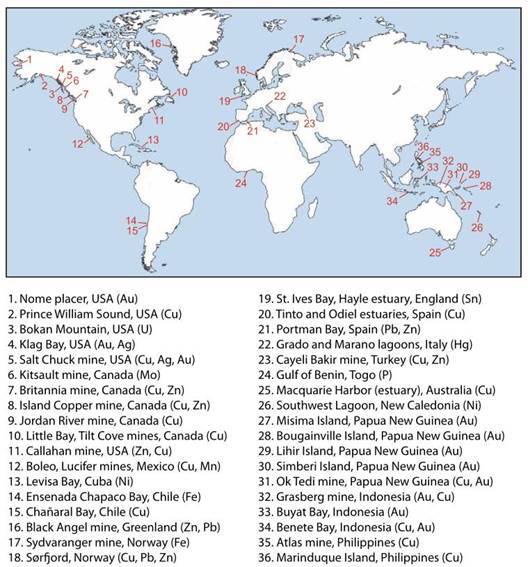
Fig. 1 Coastal sites impacted by the dumping of residuals from mining activity (taken from Koski 2012).
This research presents a compilation of existing knowledge about DSTP in the world and its use as an alternative for mining. An analysis of the main practices, as well as the environmental impacts that this technology brings about is made.
PRINCIPLE OF OPERATION OF DSTP
The DSTP general concept proposes that tailings move by gravity through a pipe from the plant to a mixing / de-aeration tank, the tailing is mixed with seawater in an approximate ratio of 1: 1,5 by volume. The mixing tank is usually located on the same coastline (Fig. 2).
The difference in density between tailings and seawater will be equalized by introducing seawater into the tank using a feed pipe. The seawater taking is usually carried out at more than 60 m depth to ensure adequate mixing density. After the mix, the diluted tail will flow through an underwater pipeline with a density of about 1 100 kg /m3.
The depth of tailings outfall should be appropriate to the local characteristics, but in most cases, it is done at minimum depths of 30 m below seabed (GESAMP 2016). The above is because the exit point is below the zone of deeper sunlight (euphotic zone), also from the zone in which shore wind driven currents can occur. The angle of the submerged pipe, as well as the submarine slope, should be approximately 12° (Shimmield et al. 2010).
Owing to the tailings and water mixing at more than 50 m deep is denser than sea water, after the exit, the tailings will flow down the marine slope. This large movement is called the lutytic flow.
The tails will be deposited along the flow path. A density equal to the seawater is eventually reached at the periphery of the density stream, part of the liquid fraction and some of the finer particles will escape at this point and will create a subsurface plume in the water column. It occurs on disconformities of density in the water column.
The remaining solids in the lutytic flow, especially the coarse fraction, will keep moving down the slope. In the pit (main deposition zone), a diluted plume with vertical expansion can occur, it is known as nepheloid layer.
Finally, the sediment escapes from the sub-surface shadow and will sediment on the ocean floor (Skei 2006). The process of density flow and formation of the feathers is consistent with the pattern that describes how sediments are transported from their terrigenous origins.
Based on the above, the modulation of the tails’ performance is made based on the performance of the terrigenous sediments that flow from the estuary of the rivers to the deep ocean basins.
MAIN DIFFERENCES BETWEEN DSTP AND COMMON TAILS DEPOSITS
The main reason for choosing DSTP above the common storing means of these residuals on land is based on multiple factors. The main elements are the lack of space for building large tailings dams, the reduction of environmental impacts on the surface and the reduction of maintenance costs.
On the other hand, common tail dams normally occupy large areas and require certain specifications in topography. If the available area is limited, it influences the storage volume. In addition, local geology is not always ideal to be used with these purposes (Poling et al. 2002).
It is also noted that the external supply of raw material for the maintenance and building of tailings dams affects the budget of mining activities. Ground storage facilities also have to deal with rains, which can cause the discharge of pollutants due to erosion or dikes breaking.
One of the main advantages of using DSTP is in the treatment of sulphurous tails. The storage of these tails in the deep sea allows inhibiting the oxidation of the sulphides, because the volume of oxygen in the water is lower than in the air (Dold 2014).
With emphasis on costs, there are different criteria from specialized sources that assess the cost of both technologies. Some say, the investment is higher in the DSTP (World Energy Information Service website), while others such as Poling et al. (2002), consider that this technology leads to low capital investment costs.
However, consulted sources agree that the closing of the DSTP and the operational cost is low in comparison with conventional tails dams (Poling et al. 2002).
On the other hand, DSTP reduce risks related to geotechnical and hydrological problems. In addition, when evaluating the whole project, it is conclusive that the expense favors the DSTP.
DSTP environmental impacts can be grouped into primary and secondary. The main physical impact of DSTP will be the physical coverage of the benthic habitat (Shimmield et al. 2010).
The secondary effects occur due to the influence of the toxic components present in the tails, which become bioavailable in the marine environment. These may include chemical processes, metals, suspended solids and sulfur components.
At the same time, it is considered that the potential risk of biological impacts depends on the level of bioavailability, toxicity and sensitivity of the impacted marine organisms (Shimmield et al. 2010).
It has been observed that the bioavailability increasing in marine organisms depends on the absorption capacity of loose metals by the food chain. If tails buries habitats or accretions reach toxicity, local biodiversity suffers severe damage (European Integrated Pollution Prevention and Control Bureau).
Therefore, the use of inert materials in the construction of DSTP and minimizing the dispersion of pollutants in the marine environment reduces the risk of negative environmental impacts.
Taking into account these considerations, the technical design and direction of the processes for the tailings disposal in deep waters should focus on preventing them from entering the shallow, biologically productive and oxygenated zone.
Sustained in preventive reasons, it is suggested that:
The exit of tails has the appropriate depth, according to local characteristics:
The angle of the slope allows the tail to fall to the ocean depths.
The tails have the proper density.
Due to operational failures, the air and water suction by marine organisms is not impeded.
Other phenomena, such as underwater landslides, can damage the pipeline and cause the discharge of pollutants in shallow waters.
INTERNATIONAL DISTRIBUTION OF DTSP
The DSTP has been introduced and used in several mining regions of the world. During the last decades, this technology has been currently used in 18 mines (Dold 2014), which represents less than 1% of all the means used for the disposal of waste in large mines.
In these projects, the tails are deposited at a depth ranging between 30 m to 1 100 m and therefore can be considered as DSTP. Table 1 shows a summary of the mining sites practiced by the DSTP. It includes information about the country in which it is located, as well as the daily quantity of stored tails, the final depth of the pipeline and the depth of the designated area for the final deposition.
Table 1 Mining sites that use DSTP (Vogt 2012; Shimmield et al. 2010; Poling et al. 2002; Hughes et al. 2015; Asmund, Broman and Lindgren 1994; Ellis 1994; Moran 2008; Hofer 2008)
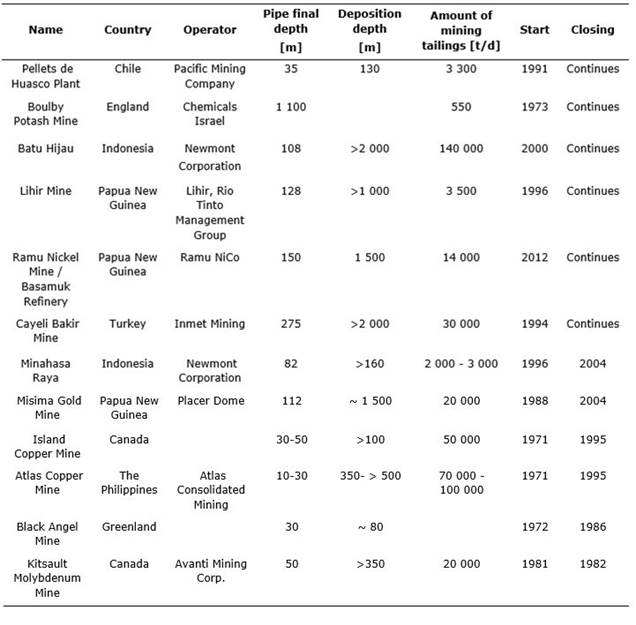
EXPERIENCES IN THE IMPLEMENTATION OF THE DSTP. CASE STUDIES
The following cases are examples of the DSTP implementation in different mining sites and they also illustrate the environmental risk that this technology implies. They also seem to be a proper alternative to the provision of tails on land, as long as they are designed and executed in an adequate environment.
Island Copper Mine, Canada
Island Copper mine is the best documented case study in the DSTP implementation. From 1971 to 1995 more than 400 million tons of tails were deposited on the seabed of Vancouver Island. The tails were the result of the flotation process used in the benefit of copper sulphides and molybdenum minerals.
After the closure of the mine, in 1996-2000 stage, environmental supervision was carried out in the areas affected by the DSTP. As a result, it was obtained that neither of the established environmental threats appeared prior to the development of the project.
These results showed that the bioaccumulation of heavy metals did not occur in a significant magnitude and consequently fishing activities were not severely affected.
It is known that salmon and crab fishing did not stop their production over time. The availability of biodiversity was reduced in the area of benthos, especially where the proportions of sedimentation exceeded 20 cm/yd (Poling et al. 2002), it was finally considered that the impact was not perceptible when the amount did not exceed 20 cm/yd (Hofer 2008).
However, it should be noted that biodiversity changed and new species appeared when the spaces affected by the DSTP were recolonized (Poling et al. 2002).
The yard (symbol: yd) is the basic unit of length in the measurement systems used in the USA and the United Kingdom. Equivalent to 0,9144 meters.
The study also showed that the deposition area was considerably higher than expected, due to the incidence of strong tidal currents and the mixture in the water column (Shimmield et al. 2010). It proves that there was a problem in the operation of the tailings modeling flow in the deep-sea (Dold 2014).
Nickel Ramu Project, Papua New Guinea
The Ramu Nickel mining project is in charge of mining and refining lateritic ore to produce nickel and cobalt. It is located in the province of Madang and the DSTP is the option chosen for the provision of tails, which is located in the Vitiaz strait (Fig. 3).
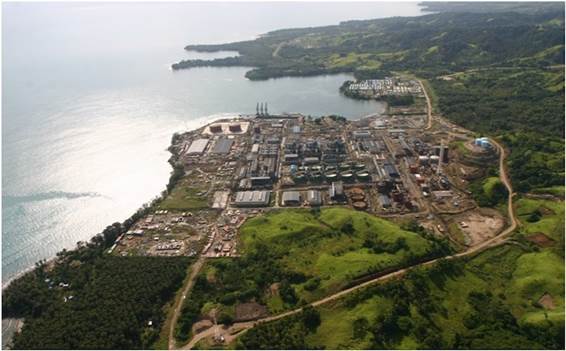
Fig. 3 Ramu Nickel in Papua New Guinea (image taken from https://ramumine.wordpress.com/tag/ramu-nickel-mine).
The refinery produces around five million tons of tails every year; during the development of the project, it is expected to produce 100 million tons of this residual in total. In the regional context, the basin associated with the Strait of Vitiaz receives a significant volume of natural sediments (estimated 80 million t/y) mainly from rivers that drain from the mountains. For these reasons, DSTP is the preferred option for handling the tails.
The Aquatic Resources Agreement of Papua, New Guinea (1982) allows a mixing zone between the discharge point and the border from which the water quality standards have to be met. In the mixing zone, these standards can exceeded.
The tests showed that Ni is one of the toxic elements present in the tails in proportions of 0,7 mg Ni/g dry weight and in interstitial water at higher concentrations than those established by the seawater quality criteria. However, bioassays performed on marine reference species (selected for its Ni sensitive) indicate that the settled tail was not toxic.
Black Angel Mine, Greeland
In the period between 1972 and 1986 the Black Angel mine in Greenland disposed eight million tons of tails at a depth of about 80 m. The concentration of metal in the seawater was already high due to the natural exposure of sulfur ores and with the deposition of the tails, the concentration increased. Although it was predictable that the tails contained only insoluble sulphides, the lead and zinc phases were dissolved causing high concentration values in water and biota (Poling and Ellis 1995).
As a complement, the water column turned out not to be permanently stratified, which led to the expansion of the tails in the upper layers. Therefore, changes were made to increase the density of the mixture (Asmund, Broman and Lindgren 1994, Poling and Ellis 1995).
Though metals concentration decreased, it is still spreading and the contamination effects cannot be prevented. The bioavailability of metals has been located up to 70 km from the spilling point of the tails and they have been found in fish, prawns and albatrosses (Asmund, Broman and Lindgren 1994).
The previous evidences are an example of the difficult predictability of negative impacts caused by the dispersion and the geochemical action of the tails in the marine environment.
Lihir Mine, Papua New Guinea
From Lihir mine in Papua, New Guinea, at about 3,5 to 4,5 million tons of tailings are discharged annually to the Pacific Ocean at a depth of 128 m (Poling et al. 2002).
The tailings are made up of reagents used in the beneficiation process such as cyanide and calcium carbonate. It is also composed of residuals from the flotation process, dissolved metals (zinc, copper, arsenic, cadmium, mercury, lead, nickel, chromium, and silver), water resulting from the decanting process and the cooling of some plants.
On the other hand, the deposited solids are distributed granulometrically in 5 % of clays, 93 % of silts and 2 % fine sands. The mixture of the tails is discharged with a pH of 2,3 and a temperature of 34 °C (Poling et al. 2002).
Gold mine in Misima, Papua, New Guinea
The Misima mine was the first of its kind, using a deposition area up to 1000 m deep below sea level for depositing tails. To maintain the coastal biota, the tailings were discharged 112 m depth and below the picnocline, thus preventing the rise of the residual in the water column (Hofer 2008).
Despite these measures, several operational failures occurred in the process of drafting sea water and the air entering the pipeline, as well as accidents resulting from underwater landslides that damaged the pipes. These accidents caused dispersion of enriched cyanide and metals tailings in the shallow water layers (Shimmield et al. 2010).
One of the most relevant incidents occurred in 1997, when the tailing pipe was broken to 55 m depth, due to an underwater landslide (Poling et al. 2002). The discharge continued at this depth during six months because suitable resources to stop these wastes were not available.
Studies show that nearly 10 %-30 % of the tailings flow were far from the current main density and formed subsurface plumes with 10 m-200 m thickness, but only below mixing zone depths (Moorhead 2013).
In spite of not directly affecting the photic zone, the subsurface dispersion of the plume increased the deposition area. Metal contamination covered a distance greater than 4,4 km from the discharge point (Poling et al. 2002).
Batu Hajiu, Indonesia
The Batu Hajiu mine in Indonesia deposits more than 140 000 tons of tailings in Senunu Bay every day. The tailings descend as a density current through a canyon at 3 000 m-4 000 m depth below sea level (Fig. 4).
Although the tailings are confined to the deposition area and the standards for water around the mixing zone are met, an Indonesian environmental study showed that a group of fish of commercial interest and others such as the squid were experiencing a significant decrease of their population (Poling et al. 2002; GESAMP 2016).
In addition, the use of inadequate materials for the pipe caused two colonies and therefore freed significant quantities of tailings in shallow water.
Copper and zinc mine of Cayeli Bakir, Turkey
The underwater deposition of tailings from Cayeli Bakir mine turns out to be an optimal environmental option for the storage of this residual. This is the result of the implementation of an objective assessment of the oceanographic and marine biology of the Black Sea at the time of designing the DSTP and establishing the conditions for the deposition (Vogt 2012).
The procedures have been carried out based on the "good management practices" precept and it included an installation for the de-aeration and a tank for mixing the seawater with the residual using water of 15 m depth (Vogt 2012).
A slope of 350 m length discharges the mining tailings and the pipe pours into the anoxic zone at 250 m depth. The Black Sea has been scope of oceanographic and biological research for many years and this recorded information was the basis for designing the outfall and the location for the discharge.
The zone for the final deposition of the tailings is in anoxic waters higher to 2 000 m depth.
It is added that even the Black Sea is an inner sea, it favors stratification with a large anoxic zone (90 % of the water column), and permanent picnocline at 35 m-150 m depths that limit the exchanges between the surface and the deep water.
In this case, the discharge is favored by the conditions of anoxia that occur from 150 m depth with hydrogen sulfide concentration greater than 3 mg/l.
On the other hand, depths are devoid of marine life and the existing hydrogen sulphide allows precipitating heavy metals contained in the tailings. Studies have shown that no residual dispersion occurs and the plume does not reach surface waters.
KNOWLEDGE LEARNED IN CASES OF STUDIES
The environmental monitoring programmer at Island Copper Mine (Canada) represents one of the most extensive study of the extent and geographic range of effects and recovery from submarine tailings deposition (Shimmield et al. 2010).
In the 1970s, localized tailings plumes, driven by tidal jets, deposited tailings on algal forests and in depressions in the rocky reefs in some of the shallow bays (Ellis 2006). At this period, it was considered that the muddy bottom benthos would be eliminated under the tailings deposits and that the plankton was at risk due to contamination and reduced photosynthesis caused by the higher turbidity.
In Papua New Guinea, the placement of tailings in deep waters has been used as a waste management option for more than 20 years (with the objective of mitigating and managing the environmental impacts of mining in the emerged areas).
At the currently operating, mine Ramu Nickel, consultancy work showed by GESAMP (2016) found:
Likely upwelling from the prevailing onshore current at depth will inevitably cause some fraction of STD material to enter the ocean over a range of depths. This will be transported as patches of turbid water well out of the source area;
Ecological damage over the wider Astrolabe Bay region will greatly be increased towards the North West up to Madang and as far as Kar Kar Island. This will clearly have significant biological impact, including adverse impact on both shallow and deep-water fish.
The deep-sea oceanographic cruise realized by MADEEP 2014 in Basamuk Bay (cited in GESAMP 2016), the Dr. Ralf Mana confirm that the STD was impact the periphery area and the pollution is at 500 m below the sea level.
In the study published by GESAMP (2016), it show how the mine Lihir (current operating), influence the environment. The principal’s aspects treated were:
Very large differences in the biological assemblages presented in affected versus reference stations;
There are still measurable numbers of meiofauna in the surface layers of the impacted sediment;
The sediments contain higher concentrations of metals in both solid and aqueous phases, including eco-toxic elements such as Cu, Cd, and As.
Misima mine (closed) has caused several environmental problems at the site of DSTP. According to the GESAMP report:
Exist clear differences between the benthic community of impacted and the non-impacted stations;
Stations adjacent to the DSTP are impacted by mine tailings;
Stations further away from the mine have been impacted either directly through mine tailings deposition or indirectly through post-depositional resuspension and re-deposition;
Some impacted stations show some degree of post-impact recolonization.
Norway adopted deposition in a routine mine at an angle of approximately 300 m depth in 2015 (Fig. 5). According to GESAMP (2016), the key elements for the request of Nordic Mining Company were:
An intensive study of streams in the field including modeling and measurements,
Other alternatives to marine disposal: alternative use of tailings and sites for eliminating them; (Alternatives to disposal at sea: alternative use of tailings and alternative sites for disposal)
Detailed study of marine biodiversity in the fiord;
Characteristics of tailings (heavy metals) and chemical processing products.
The conclusion of the Norwegian Environmental Agency was expressed in a compliance permit, in accordance with the provisions of Pollution Control Act and the integration proposal nature. According to the report from GESAMP (2016), the permit was based on an evaluation of environmental disadvantages against the positive effects for society. The conclusion was giving the permit in this case, in view of the positive effects for society overcome negative environmental impacts.
On the other hand, the proposal of two mining companies was declined (Chatham Rock Phosphate (CRP) and Trans-Tasman Resources (TTR)) for the dumping of tailings in deep waters was rejected in New Zealand.
Permits were denied due to several uncertainties, such as:
Lack of depth in the studies about environment and the importance of the negative effects for the environment and existing interests (e.g. fishing activity);
Significant and permanent adverse effects in the existing benthonic environment;
It was not clear if the environmental effects could be mitigated;
Lack of clarity about the scope of the economic benefits for New Zealand;
Importance of possible adverse environmental effects; and
The capacity of the environment to withstand the impacts caused for the deposition of tailings.
CONCLUSIONS
DSTP is common in many country of the world and the new and existing mining companies will look to marine disposal to dispose of their mine tailings.
According to what it is established on protocols and international treaties for protecting the marine environment and the research developed about the impacts caused; the DSTP should be avoided unless very strict guarantees are given that it will not cause any damages to the environment.
A technological and ecological alternative prior to the DSTP must be the execution of tailings pre-treatment and it must be ensured that the toxic compounds do not reach the Euphotic Zone.
Low costs and a simple closing of operations are the fundamental reasons why an increasing number of studies focus on the DSTP. A new mining scope on a global scale emphasizes a perspective of general change that recognizes the DSTP as an effective alternative.
Feasibility studies for DSTP projects must be rigorous and very specific for each site. It is necessary that countries that introduce this kind of technology, implement the specific legislative actions to regulate this activity. The malfunction has occurred in cases where the above has not been taken into account.













